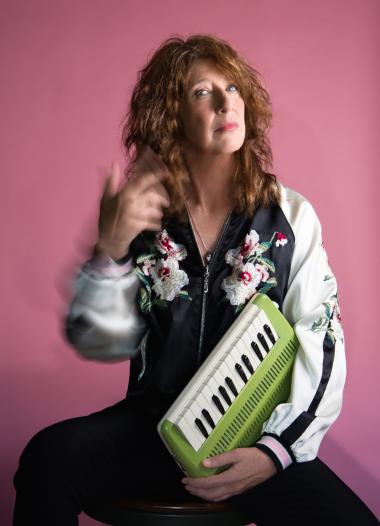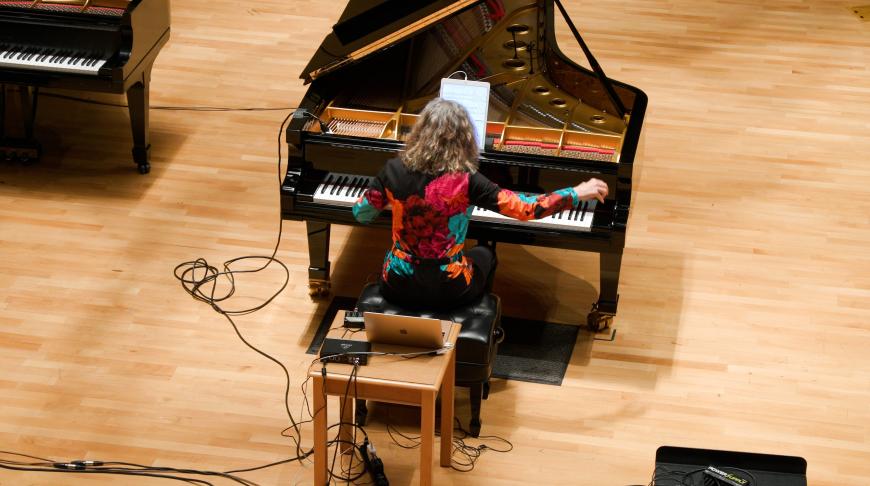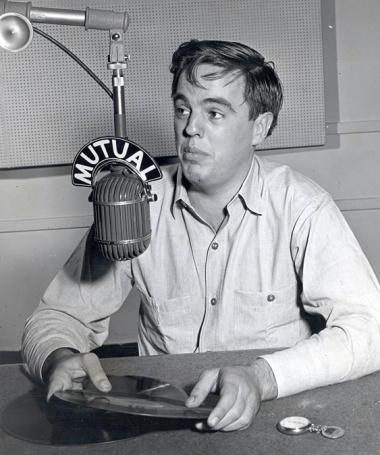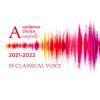
The influential keyboard series Piano Spheres entered its 28th season on Tuesday, Sept. 20 with a meticulously modulated recital by Vicki Ray at the Colburn School’s Zipper Hall. Over the course of four compositions, Ray (with assistance from Aron Kallay) laid out an entire electroacoustic cosmology — from an electronic deconstruction of a wax-cylinder field recording by Alan Lomax of an African American gospel tune to a four-hand, four-piano electro-dive into the subatomic life of minerals.
Ray (who was recently selected “Best Instrumental Soloist” in SFCV’s 2021–2022 Audience Choice Awards for Los Angeles) was a star student of Leonard Stein’s in 1994 when he invited her to become one of the founding members of Piano Spheres. The series’ mandate was to showcase the most innovative directions in keyboard compositions, and Ray has participated in every season since.
In keeping with tradition, her recital Tuesday showcased a range of exceedingly diverse compositions: João Pedro Oliveira’s Titanium (2014), William Kraft’s Requiescat (Let the bells mourn for us for we are remiss) (1974), Joshua Biggs’s dedication/collaboration Sound Ribbons for Vicki Ray (2022), and Ben Phelps’s Sometimes I Feel Like My Time Ain’t Long (2018).

Titanium, which opened the program with a bang, is a mind-bending example of live performance fused with instantaneous data analysis and interpolation. I’m far from a tech whiz, so I won’t try to explain exactly how the magic was created by Ray, Kallay and their tech support team. But I was content to strap in and be taken on one heck of a thrill ride.
Ray and Kallay sat together (four hands ready) at a Steinway grand, each flanked by a toy piano. The piece unfolds like an aurora of colors, fusing the acoustic qualities of the grand and toy instruments with the widest possible spectrum of electronic colorations, superhuman rhythmic patterns, and sound-bending distortions. Notes stream, cascade, and collide. Musical motifs appear and fade like images frozen on some distant event horizon — a jazz groove gives way to wisps of what might be a Chopin nocturne. What world is this where moments of quietude give way to glissandos swept across the keyboard using playing cards and earthshaking tectonic crescendos? What a ride!
If Titanium represents the current state of the art, William Kraft’s Requiescat stands as a sonic signpost along the way. Performed by Ray on a Fender Rhodes electronic keyboard, its soft tones, phase-shifting echoes, and ring modulations evoke an air of nostalgia, even though at the time the instrument’s capabilities were considered cutting edge.
As described by Kraft, “the compositional techniques of this work utilize a version of 12-tone rows, treated as hexachords that vary gradually, in addition to ostinati, clusters, some aleatoric elements within circumscribed parameters, and all the sustaining and reverberation effects of the instrument.”
To add a percussive element (Kraft was for many years the principal timpanist of the Los Angeles Philharmonic), the pianist is called upon to strike the strings adeptly with four marimba mallets. These struck notes are subjected to the same form of electronic transformation and distortion. The effect Kraft creates is imaginative electronically while remaining within a distinctly modernist framework.

Perhaps the most intriguing innovation of the moment is something like a feedback loop. With 2022 technology, a pianist can perform a notated score, improvise on that score, and have the notes of that improvisation electronically integrated into the performance, creating a challenging succession of performance, improvisation, performance, improvisation — where no two performances will be alike.
To create Sound Ribbons for Vicki Ray, Joshua Biggs and Ray crafted a work that incorporates past recordings of past in-the-moment improvisations. The recordings of Ray’s past performances were given an added dimension, Biggs explained, by being “digitally transcribed and then reorchestrated for a chorus of five sampled pianos spanning four centuries. ... Each piano’s unique temperament and timbral characteristics are further colored by electronic techniques including granular synthesis, ring modulation, and convolution reverb, combin[ing] and collid[ing] to offer new meanings and expressivities to Vicki’s playing.”
To say Ribbons requires virtuosic ability is an understatement— like flying without a net. Ray flew.

Sometimes I Feel Like My Time Ain’t Long is described by its composer as a “time-stretched set of variations.” The core material comes from an archived wax-cylinder recording at the Library of Congress made by Alan Lomax of an a cappella chorus. Just 20 seconds in length, we hear it complete with all its pops and scratches. But it is exactly this disintegrated quality that makes the voices ghostly harmonies from long ago.
As the listener is drawn into this distant past, the piano begins a set of variations that initially mirror the chords of the song. But over the course of nine repetitions, the song is slowly deconstructed and elongated like dripping molasses. The words devolve until they are simply harmonic tones and overtones. The word “Lord” becomes a sonic mantra, while the piano spins more and more complex threads around the central theme, until the piece fades into the realm of spiritual transformation.
Returning for a brief encore, Ray sat again at the Fender Rhodes. With a sly smile she paid homage to another Ray — Manzarek (of the Doors) — spinning out those familiar glistening phrases from “Riders on the Storm.”



